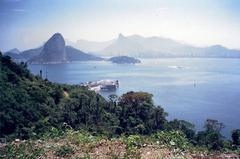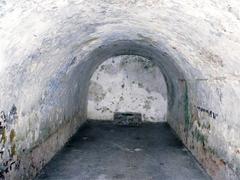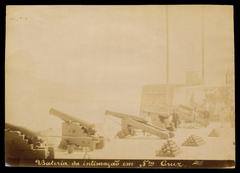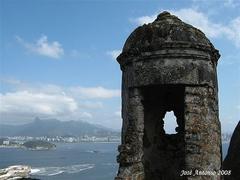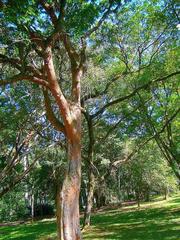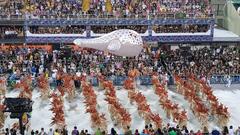
Fortress of Santa Cruz da Barra, Niterói: Visiting Hours, Tickets, and Historical Significance
Date: 14/06/2025
Introduction
The Fortress of Santa Cruz da Barra, majestically positioned at the entrance of Guanabara Bay in Niterói, Brazil, is an enduring monument to the nation’s colonial and military legacy. Built initially by the French in 1555 and later expanded by the Portuguese, this fortress has long been a sentinel guarding Rio de Janeiro’s crucial maritime gateway. With its robust architecture, storied past as both a stronghold and prison, and panoramic vistas of the bay and Rio’s skyline, the fortress stands as a living museum and a must-see attraction for visitors to the region (Aventuras na História; Cidade de Niterói; visit.niteroi.br; whichmuseum.com).
This guide compiles key information on the fortress’s history, architectural highlights, cultural significance, visiting hours, ticketing details, accessibility, and practical travel tips—equipping you for an enriching visit to one of Niterói’s premier historical sites.
Historical Overview
Colonial Foundations and Strategic Importance
The origins of the Fortress of Santa Cruz da Barra date to 1555, when French Admiral Nicolau Durand de Villegaignon erected a modest fortification to support the France Antarctique colony. Following the expulsion of the French in 1567, the Portuguese recognized the site’s strategic import and transformed it into a pivotal defense point for Rio de Janeiro, overseeing all naval access to the city. Its placement—directly across from Fort São João—created a formidable crossfire that made unauthorized passage into Guanabara Bay virtually impossible.
Architectural Evolution
Over the next centuries, the Portuguese reinforced and expanded the fortress to adapt to evolving military needs. Key enhancements included thick stone walls, multiple artillery batteries, vaulted casemates for munitions, and barracks for garrisons. By the 18th century, the fortress comprised 44 cannons and a two-level system of casemates, implementing a “horizontal defense” that allowed low-angled artillery fire across the water (Cidade de Niterói). The Chapel of Santa Bárbara, constructed in 1612, remains the oldest church in Niterói.
Role in Major Historical Events
Santa Cruz da Barra played decisive roles in thwarting foreign invasions, most notably repelling the French corsair Jean-François Duclerc in 1710. Its artillery forced Duclerc’s fleet to abandon a direct assault, contributing to the fortress’s reputation as “almost impregnable.” Later, during the 19th-century Christie Affair, the fortress saw renewed upgrades, ensuring its continued role in Brazil’s defense well into the modern era (Aventuras na História).
The Brazilian “Alcatraz”
Beyond its military function, the fortress served as a notorious prison—its isolation making escape nearly impossible. Until the 1940s, access was limited to boat crossings, often through treacherous waters. The site’s formidable security made it infamous as the “Brazilian Alcatraz,” with few recorded escapes throughout its operational history (Aventuras na História).
Transition to Heritage and Tourism
As traditional fortifications became obsolete, Santa Cruz da Barra’s defensive role diminished by the mid-20th century. Recognized as a national heritage site in 1939, it is now managed by the Brazilian Army as a museum and cultural space, visited by thousands each month (Jornal Hora Certa).
Architectural Features and Cultural Significance
Layout and Construction
The fortress’s architecture harmonizes with the rocky promontory at the bay’s entrance, using locally quarried stone, lime mortar, and granite for enduring strength (Castlepedia). Notable features include:
- Chapel of Santa Bárbara: Founded in 1612, preserving sacred art and serving as a spiritual anchor.
- Artillery Batteries and Casemates: Including original 17th-century cannons and advanced defense configurations.
- Barracks and Administrative Buildings: Constructed in the “traçado italiano” style, with symmetrical courtyards and functional stonework.
Integration with Landscape
The fortress’s design follows the natural contours of the land, offering commanding views of the Atlantic and the Rio skyline. Its setting is part of a federally protected heritage landscape, recognized by UNESCO since 2012 for its natural and cultural value (Cidade de Niterói).
Living Museum and Community Role
Santa Cruz da Barra’s military technology collection spans from 17th-century artillery to modern pieces. It regularly hosts religious festivals, cultural events, and educational workshops, maintaining a strong link between past and present (Castlepedia; Out of Your Comfort Zone).
Environmental Significance
The fortress is surrounded by Atlantic Forest remnants, offering opportunities for birdwatching and nature walks alongside its historical attractions (Castlepedia).
Practical Visitor Information
Location and Directions
- Address: Estrada General Eurico Gaspar Dutra, s/nº – Jurujuba, Niterói, RJ, Brazil
- Telephone: +55 21 2710-2354
Getting There
- Car: Via the Rio-Niterói Bridge, with parking near the entrance.
- Ferry: From Praça XV (Rio) to Niterói, followed by taxi or ride-sharing (approx. 7 km to fortress).
- Taxi/Ride-Share: Direct from Rio or Niterói, convenient for groups (rioculturalsecrets.com).
- Bus: From central Niterói to Jurujuba (service may be limited; confirm schedules).
Visiting Hours and Admission
- Days: Tuesday to Sunday and public holidays (closed Mondays)
- Hours: 10:00 AM – 4:00 PM (last tour typically 30–60 minutes before closing)
- Admission Fees (2025):
- General: R$6.00
- Half-Price (students, select military, etc.): R$3.00
- Free: Children under 12, seniors (60+), people with special needs, public school students and teachers (with documentation), military personnel and families, WWII veterans
(visit.niteroi.br; whichmuseum.com)
Prices subject to change—verify on the official website before visiting.
Guided Tours
- Required: All visits are guided, both for security and heritage reasons.
- Frequency: Tours depart every 30 minutes, lasting 60–90 minutes.
- Languages: Primarily Portuguese, with limited English/Spanish (advance arrangements recommended for non-Portuguese speakers).
- Group Bookings: Schools and organizations should book in advance via [email protected].
Accessibility and Amenities
- Physical Accessibility: Historic architecture limits wheelchair access; expect uneven surfaces, steep walks, and stairs. Contact ahead for assistance if needed.
- Facilities: Restrooms, parking, small museum/exhibit space. No on-site café—bring water and snacks.
- Visitor Tips: Wear comfortable shoes, bring sun protection, and carry water, especially in summer months.
(whichmuseum.com; Turismo Niterói)
Photography and Conduct
- Allowed: Photography is permitted in most areas (restrictions may apply for security or preservation).
- Tripods/Drones: Require prior authorization.
- Behavior: Respect all signage, do not climb on cannons or enter restricted zones.
Highlights and Points of Interest
- Chapel of Santa Bárbara: Oldest church in Niterói, central to the fortress’s spiritual and community events.
- Artillery Batteries: Over 40 historical cannons and casemates, with interpretive signage.
- Prison Cells: Insight into the fortress’s darker past as an inescapable prison.
- Panoramic Terraces: Unrivaled views of Guanabara Bay, Sugarloaf Mountain, and Rio’s skyline—ideal for photography.
- Museum Exhibits: Displays of artifacts, maps, and memorabilia that bring the fortress’s history to life.
Frequently Asked Questions (FAQ)
Q: What are the visiting hours?
A: Tuesday to Sunday, 10:00 AM to 4:00 PM. Closed Mondays.
Q: How much is admission?
A: R$6.00 full, R$3.00 half price, with free entry for eligible groups.
Q: Are guided tours mandatory?
A: Yes, all visits are guided for security and preservation.
Q: Is the fortress wheelchair accessible?
A: Accessibility is limited; contact the fortress in advance for assistance.
Q: Can I take photos?
A: Yes, except in restricted areas. Tripods/drones require permission.
Q: Is parking available?
A: Yes, near the entrance.
Visitor Tips and Best Practices
- Best Times: Early mornings or late afternoons for cooler weather and optimal lighting.
- Duration: Allow 1.5–2 hours for a full visit.
- Combine Attractions: Visit nearby sites like the Niterói Contemporary Art Museum or City Park for a full day of exploration.
- Safety: The site is secure and under military oversight; follow all guidelines.
- Language: Tours are in Portuguese; English support is limited—consider arranging private guides if needed.
Booking and Contact
- Email: [email protected]
- Phone: +55 21 2710-2354
- Official Website: www.dphcex.ensino.eb.br
- Tourism Info: visit.niteroi.br
Further Recommendations
- Combine with Local Cuisine: Explore Niterói’s seafood markets after your tour (rioculturalsecrets.com).
- Weather: Summer (Dec–Mar) is hot/humid; winter (Jun–Aug) is milder—plan accordingly.
- Cultural Events: Check schedules for special events or exhibitions.
Summary
The Fortress of Santa Cruz da Barra encapsulates Brazil’s military ingenuity, colonial resilience, and cultural evolution. With its striking architecture, storied history, and breathtaking views, it promises a rewarding experience for all visitors. Plan ahead, respect site regulations, and take advantage of guided tours for a deeper understanding of this iconic landmark.
For up-to-date information, consult the official Brazilian Army website, Niterói Tourism Board, and IPHAN. Enhance your visit with the Audiala app for audio-guided tours and stay connected for further updates on Brazil’s heritage.
Sources and Further Reading
- Aventuras na História
- Cidade de Niterói
- visit.niteroi.br
- whichmuseum.com
- Jornal Hora Certa
- IPHAN
- Castlepedia
- Out of Your Comfort Zone
- rioculturalsecrets.com
- imaginariodejaneiro.com
- odiariodeumaviajante.com.br
- Turismo Niterói
